Testing the effects on
seed germination using Aspergillus inoculate on
(Chameadorea radicalis)
Abstract
Although by far, this is not
a scientific experiment, it is however designed to show some
of my fellow palm and tropical gardening enthusiast & friends,
the results I obtained using Aspergillus in the
seed germination process.
As many of us already know, germinating certain seed, especially
those in the Palmae family, can take many months and even
years in some cases for the radicle and first plumule to form.
In this test, I'm attempting to analyze and document the progress,
as to the length of time it takes, plus the quantity of seed
in each case that do germinate of the species, Chamaedorea
radicalis, using seed treated with Aspergillus
and a Control set with out the seed being treated. And finely
by checking the root system for any unusual growth, by comparing
both the treated and untreated plants.
Bottom line: To determine if Aspergillus
aids and enhances seed germination and plant development.
The Set up
I used a plastic covered tray
6 1/2 inches by 5 inches and filled with sterilized seed starting
mix. 12 Chamaedorea radicalis seeds were put into
a baggy with a teaspoon of Aspergillus inoculate
and agitated until all seed were completely covered with substance,
these were than planted in the potting mix. 12 Chamaedorea
radicalis seed were used as a control. Trays were watered
and placed in a warm but dark area. No bottom heat was used and
I only watered once, about 20 days into the experiment. Trays
are inspected at least once a week.
Note: All seed used in this
experiment are fresh and were harvested October 2000. No fertilizer
or plant stimulants were used whatsoever including EcoSane, HB-101,
B1 or other plant hormones.
In the Past
We have all tried the baggy method
or in the pot, (they either grow or else they rot) method, with
some and some not-so successful results. Bottom heat is usually
recommended and it certainly wouldn't hurt in speeding up seed
germination. But usually we fall short of our expectations, our
special palm seed, that we dreamed someday towering over head,
for all the world to see, doesn't happen like we planed. Sometimes
we forget to water and as time goes by we seem to forget about
what we did back 6 months ago and when we do remember we find
a disappointing dried pot or dry moldy seed left in our long
forgotten baggy. We must try and check each and everyday our
seed, in order to accomplish our mission.
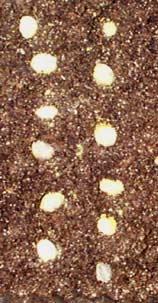
Treated Seed
Image taken November
19, 2000 Fig1 |
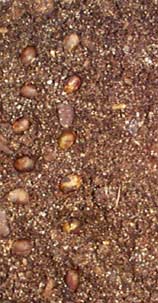
Untreated Seed
Control
Image taken November 19,
2000 Fig2 |
Chamaedorea radicalis seed, half of which have been treated
with Aspergillus the other half are left untreated.
These seeds were planted on a seed starting mix, November 19,
2000. Please note that no bottom heat was used in the germination
process. Covered seed trays were kept in a warm room without
sunlight.
Results in 45 day as seen
below
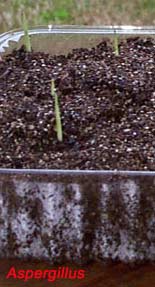
Aspergillus treated seed 45 days
later 4 seed have sprouted. Fig3 |
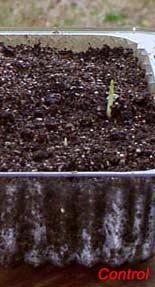
Control set 45 days later only one
seed has sprouted Fig4 |
Chamaedorea radicalis seed started to germinate January 3,
2001, notice as we begin to compared the untreated seed to that
of the Aspergillus treated seed, the germination
ratio for the latter is 4 to 1.
January 3, 2001 ratio is 4 (treated) to 1 (untreated)
January 10, 2001 ratio is 5 (treated) to 2 (untreated)
January 18,
2001 ratio is 6 (treated) to 3 (untreated)
January 21, 2001 ratio 7 (treated) to 3 (untreated)
January 25, 2001 ratio 8 (treated) to 3 (untreated)
January 27, 2001 ratio 9 (treated) to 5 (untreated)
January 28, 2001 ratio 9 (treated) to 6 (untreated)
*February 4, 2001 ratio 9 (treated) to
6 (untreated)
Note:
45 days from time of planting to when first noticed that seed
sprouted.
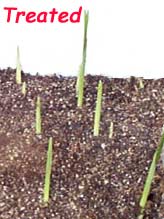 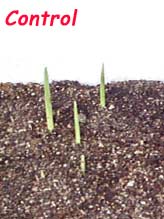
Image taken January 27, 2001. Showing
treated set with 9 sprouted seed (Fig5
left) whereas the control
set (Fig6 right) only has 5 sprouted seed. |
|
Conclusion
January 29, 2001
After 70 days from sowing seed, this experiment shows
early on, that the seed treated with Aspergillus, did
indeed germinate sooner than the control set. From January 3rd
to the 25th the ratio was 8 treated to 3 untreated. As time continues
from January 27th to the 29th, this shows an increase of untreated
seed at a ratio of 3 untreated to 1 treated. Although the untreated
seed is now germinating at an increased rate, this however, still
demonstrates, that the seed treated with Aspergillus did in fact
germinate sooner, not only that, but the new growth shown in
the latest set of images (Fig5-Fig6), is already beyond the first plumule
stage, as the eophyll (first leaf) is about to emerge on two
of the treated seedlings, whereas it is not present on the control
set.
February 4, 2001
After a 80 days, a total of 15 seed germinated out of
24. The control set managed to produce 6 seedlings (Fig6) while the Aspergillus set
produced 9 seedlings (Fig5).
By comparing the two sets of seedlings (Fig7,
Fig8, and Fig9)
there seems to be no noticeable difference between the two sets,
both treated and control or untreated seed.
So my conclusion is, that out of the 12 seeds from each
set, 3/4 sprouted or a total of 9 seed in the treated set, while
only 1/2 or a total of 6 seed sprouted in the control set. Net ratio 3 to 2 for
the treated seed.
Continued
later
*Latest update February
4, 2001 (80 days from sowing)
Some
of the things I do,
to lose those winter time Blues!
|
Continued
Root developement of Chamaedorea radicalis
Both treated and
control set |
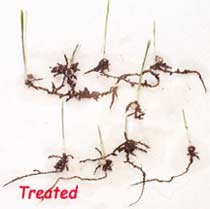
The root systems of the Aspergillus
treated seed. Fig7 |
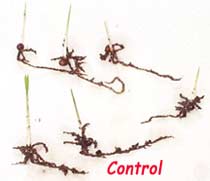
Root system on the control set of
untreated seed. Fig8 |
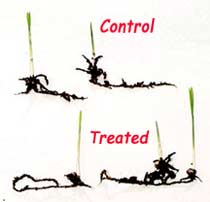
Comparing both the control and treated
roots. There seems to not be any noticeable difference in the
amount of root between the two set of seedlings. Fig9 |
|








